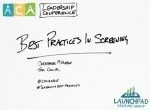 At the invitation of The Capital Network, I did my first Reddit Ask Me Anything. It was pretty fun. To do an AMA, you hang out for a specified time and anyone on the internet machine can ask you a question. Mine was all about crowd-funding – the new rules, issues, questions, concerns. Some good nuggets in there. You can read through the Q&A here. Or if you are based in the Boston area and want more detail, you can check out the TCN event it was promoting here.
At the invitation of The Capital Network, I did my first Reddit Ask Me Anything. It was pretty fun. To do an AMA, you hang out for a specified time and anyone on the internet machine can ask you a question. Mine was all about crowd-funding – the new rules, issues, questions, concerns. Some good nuggets in there. You can read through the Q&A here. Or if you are based in the Boston area and want more detail, you can check out the TCN event it was promoting here.
Comments, questions or reactions to this post? Leave a note below and I will respond to your questions.
If you enjoyed this post, you might enjoy my other posts on Angel Investing, Crowd Sourcing, Entrepreneurship.
Subscribe – To get an automatic feed of all future posts subscribe to the RSS feed here, or to receive them via email enter your address in the box in the upper right or go here and enter your email address in the box in the upper right. You can also follow me on Twitter @cmirabile and on Google+.

 angels don’t appreciate all the other quirky, sometimes fleeting, but always satisfying benefits of working with you along the way. Fact is, we are nothing without you.
angels don’t appreciate all the other quirky, sometimes fleeting, but always satisfying benefits of working with you along the way. Fact is, we are nothing without you. Fool Born Every Minute (So You Think You Want to Be An Entrepreneur?)
Fool Born Every Minute (So You Think You Want to Be An Entrepreneur?) 7 Reasons Why Angel Investing Became Serious Finance
7 Reasons Why Angel Investing Became Serious Finance Creating and delivering a great pitch requires both using the right building blocks and putting them together properly. I
Creating and delivering a great pitch requires both using the right building blocks and putting them together properly. I  We’re all investors, but we’re no angels
We’re all investors, but we’re no angels I recently did a deck and moderated a talk at the Angel Capital Association Leadership Conference in Boston about what different established angel groups are doing on screening deal flow – best practices, tools, sources, staffing, fees, how group size affects it, etc. Lots of data (based on a large survey of almost 100 angel groups, mostly in the US) – some of it is pretty interesting. I have been asked repeatedly to share the slides, so here they are (email readers can access them here).
I recently did a deck and moderated a talk at the Angel Capital Association Leadership Conference in Boston about what different established angel groups are doing on screening deal flow – best practices, tools, sources, staffing, fees, how group size affects it, etc. Lots of data (based on a large survey of almost 100 angel groups, mostly in the US) – some of it is pretty interesting. I have been asked repeatedly to share the slides, so here they are (email readers can access them here). I recently did a deck and moderated a talk at the Angel Capital Association Leadership Conference in Boston about ways angel groups may evolve to adapt to changing market conditions over the coming years, particularly crowdfunding platforms allowing for new kinds of less-traditional investing (i.e. less contact with the companies, potentially less value-add, larger, less-tightly integrated syndicates). The observations represent the thinking of the leaders of some of largest groups in California, Massachusetts, Texas. I have been asked repeatedly to share the slides, so here they are (email readers can access them here). PS: thanks to George McQuilken of Angel Investing News for the nice write up on this. Maia Heymann of Common Angels, Ralph Meyers of TechCoast Angels and Jamie Rhodes of Central Texas Angel Network were awesome to work with and brainstorm with.
I recently did a deck and moderated a talk at the Angel Capital Association Leadership Conference in Boston about ways angel groups may evolve to adapt to changing market conditions over the coming years, particularly crowdfunding platforms allowing for new kinds of less-traditional investing (i.e. less contact with the companies, potentially less value-add, larger, less-tightly integrated syndicates). The observations represent the thinking of the leaders of some of largest groups in California, Massachusetts, Texas. I have been asked repeatedly to share the slides, so here they are (email readers can access them here). PS: thanks to George McQuilken of Angel Investing News for the nice write up on this. Maia Heymann of Common Angels, Ralph Meyers of TechCoast Angels and Jamie Rhodes of Central Texas Angel Network were awesome to work with and brainstorm with.